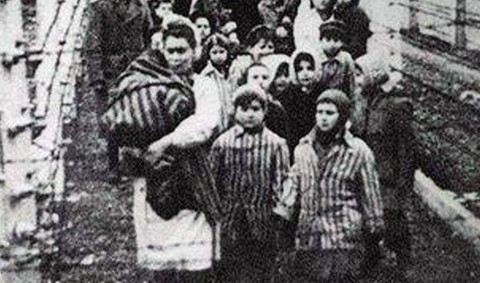At ten years of age, most children are running outside playing with dolls and with the neighborhood kids, while their parents are supporting their imagination and naïve dreams. Such a normal world changed overnight for ten-year-old twins, Eva and Miriam Mozes, when the Hungarian Army took control of their small Romanian village in 1940. Being the only Jews in the small village of Portz, the Mozes family was treated horribly by many. Racial slurs and sadistic terms and phrases became an everyday experience for the girls while in school and around their village. Soon after the Nazi invasion of Romania, the Mozes family was forced into a ghetto and eventually shipped off like cattle to the infamous concentration camp of Auschwitz. After three days of unbearable traveling conditions, the girls and their family arrived to hell on earth. Over the haunting gates, they read “Arbeit macht frei,” which translates to “work sets you free.”1

As the cattle doors of the train swung open and chaos consumed the air, Eva and her family stepped onto the selection ramp, which became their final moments together. Within twenty minutes, Eva and Miriam lost all their siblings and both parents to the gas chambers of Auschwitz. Two ten-year-old girls all alone in the darkest place on earth. Moments before Eva and Miriam were stripped from their mother’s tight grasp, German soldiers began to shout as they looked for twins. In a moment of terror and panic, the girls’ mother asked if this was considered a good thing. The Nazi soldier replied “Yes,” and the two girls were led one way while their family another.2 Eva and Miriam did not know it then, but being together in the womb allowed them to be together through the worst of times.

Processing for Eva and Miriam went differently than most due to the fact that they were now considered “Mengele twins.” This title made them special, for as long as Dr. Mengele found them to be useful subjects, they were not to be harmed. The girls were allowed to keep the clothes on their back, the hair on their head, and their lives. Now that may seem like very little, but within an hour of arriving, some prisoners met their death in the gas chambers while others were forced to shave their head and change into the well-known striped uniforms for the work camp inmates. However, the process of tattooing remained the same. This was one of the many defining moments for Eva. This is when she began to take a stand and fight for her life and for a chance to survive. She questioned, at such a young age, what right they had to permanently mark her body. She began to resist and fight against the soldiers and nurses, making it very hard for them to complete their task. She even went so far as to bite one of the soldiers, which she explained, felt so wrong, as she had been taught throughout her young life that biting someone was a forbidden thing to do. As she tells the story today, many survivors wonder how she ever survived biting a Nazi soldier.3
Eva and her twin went through processing, and were introduced to the Nazi doctor Josef Mengele, most famously remembered as the Angel of Death. He was often described as a proper man with outstanding mannerisms. In a place such as Auschwitz, Mengele stood out. His tall shiny boots and combed-over hair contrasted with the decay and death that permeated the camp. Auschwitz was the perfect place for an evil doctor such as Mengele. Here he had an unlimited supply of test subjects, who at the time had zero rights. No one overlooked his research or questioned the inhumane experiments that he conducted on the lives of hundreds. Although the Nazi regime deemed his experiments important, no scientific basis was ever found for the racial theories proposed in them.4
The girls were forced to act as guinea pigs in many of Dr. Mengele’s experiments. They sat naked up to eight hours a day, being measured and examined multiple times a week. On the days they weren’t stripped of their clothes, they were robbed of their blood and injected with unknown substances. After being injected with one of these substances, Eva became deathly ill. She even recalls Dr. Mengele, sarcastically laughing as he describes her having roughly two weeks to live. This is when Eva made a silent pledge to prove this evil enemy wrong and be reunited with her sister. Deathly ill, she was transferred to the barracks of the living dead as her conditions continued to worsen. While there, crippled by her illness, Eva forced herself to crawl across the floor in order to drink water, as she knew she needed fluids in order to survive. After battling death for three weeks, Eva had won and returned to the barracks with her sister and other twins. She had beaten death and proven Dr. Mengele wrong. If she could be brave while staring death in the face, she knew that she and her sister could survive. This animosity towards Dr. Mengele was a driving force for Eva and for her will to survive.5
Throughout her time in Auschwitz, Eva quickly learned what it took to survive the long nine-month fight for her life. She quickly became aware that if she cried over her situation, she would no longer see the sunrise the next morning. If she spent time crying, her opportunity to get bread or water would be missed, and that meant one step closer to death. And if she died, it also meant the death of her sister. If one twin died the other one would be murdered so that the doctors could run a comparative autopsy. The girls lived, not only for themselves, but also for one another. Their lives were now much bigger than just themselves and they realized that very early on.6
In November of 1944, after months of torture and living day to day, the girls began to notice changes–changes that fostered hope in the girls that was almost slipping away. By then, the camps had experienced air raids, and the experiments had stopped completely. American aircraft flying over Auschwitz helped refuel their hope for a new tomorrow. As the allies gained more and more ground, the Nazis ordered the girls from the camp. However, they refused to leave as they knew leaving would be surrendering their lives. Trying to hide their heinous crimes, the Nazis began to destroy the gas chambers and any other evidence that would tie them to the mass genocide that had taken place at Auschwitz. The barracks that had become home for the girls were burned down, and they were left to fend for themselves. Not giving up, the girls found ways to continue. Eva was a very good “organizer,” and was able to steal food and other necessities from the Nazis, allowing them to keep holding on to life.7

January 27, 1945 is a date Eva will never forget. It was a very quiet day, a complete whiteout due to heavy snow, and the girls could feel that freedom was coming. They didn’t know how or when, but they knew it was close. Days had passed when finally, another prisoner ran into the barracks informing the girls of their freedom. At first, they were not sure exactly what freedom meant; but Eva describes the words as magical. The Ukrainian-Soviet soldiers entered the camp offering the survivors chocolates, candies, and most importantly, hugs. After being deprived of love for so long, Eva described the hugs as being the most important thing that the soldiers could offer. Eva quickly realized that she and Miriam had triumphed over a great evil, and that the little promise she made to herself was now a reality. Freedom was sweet, but their worries were far from over. Acclimating back into the real world with no family was very difficult for the young girls, and liberation of the camp, unfortunately, did not mean leaving this nightmare behind. The things they witnessed and lived through while in Auschwitz continued to haunt them. Their bodies, permanently altered by the experiments, would never be the same. Miriam faced kidney issues throughout her life, due to an injection that stalled the growth of her kidney. This medical catastrophe made life very challenging, and it eventually led to her death in 1993.8

The liberation of Auschwitz was a triumph for the girls. Staying alive through the night was Eva and Miriam winning the battles, but this was them finally winning the war. Despite everything being against them, their will to survive allowed them to prevail in the most difficult of times. Eva and her sister continued to win this war many years later by sharing their story with the world and informing others of the horrors they and many others endured during the Nazi regime. Doing the unimaginable, Eva has publicly forgiven the Nazis and all who have done her wrong. This she explains is for no one other than herself and her journey of self-healing. Eva accredits the forgiveness for allowing her to experience real freedom in her life, the freedom from the pain and suffering that once clouded her soul. When she forgave the Nazis, she threw away the hold that their crimes had over her life. She even opened a museum in 1995 to honor her sister Miriam, and she continues to be a voice for survivors around the world. Frequently visiting the place that once wished to take her life, Eva leads tours and tells her story to all those who will listen. Ultimately, Eva wants humanity to love one another for who they are, never take freedom for granted, and forgive our enemies so in turn we can finally reach true freedom. As she says, “Forgiveness is a seed for peace. Anger is a seed for war.”9
- Eva Mozes Kor, “Questionnaire with Personal Answers,” CANDLES Holocaust Museum & Education Center (December 2015): 2-3. Accessed September 23, 2018. https://candlesholocaustmuseum.org/file_download/inline/2ffd2717-e5e9-4b64-9e92-5361aa0fcbc1. ↵
- Eva Mozes Kor, “Questionnaire with Personal Answers,” CANDLES Holocaust Museum & Education Center (December 2015): 2. Accessed September 23, 2018. https://candlesholocaustmuseum.org/file_download/inline/2ffd2717-e5e9-4b64-9e92-5361aa0fcbc1. ↵
- Eva Mozes Kor, “Questionnaire with Personal Answers,” CANDLES Holocaust Museum & Education Center (December 2015): 4-5. Accessed September 23, 2018. https://candlesholocaustmuseum.org/file_download/inline/2ffd2717-e5e9-4b64-9e92-5361aa0fcbc1. ↵
- United States Holocaust Memorial Museum Encyclopedia, s.v. “Racism: In Depth.” ↵
- Eva Mozes Kor, “Questionnaire with Personal Answers,” CANDLES Holocaust Museum & Education Center (December 2015): 6. Accessed September 23, 2018. https://candlesholocaustmuseum.org/file_download/inline/2ffd2717-e5e9-4b64-9e92-5361aa0fcbc1. ↵
- Eva Mozes Kor, “What does it feel like to lose a loved one to murder? How do you feel about the killer immediately after the event and after some time has passed? How does your view of the world change?”- Quora.” Quora – A Place to Share Knowledge and Better Understand the World. ↵
- Eva Mozes Kor, “Questionnaire with Personal Answers,” CANDLES Holocaust Museum & Education Center (December 2015): 6-7. Accessed September 23, 2018. https://candlesholocaustmuseum.org/file_download/inline/2ffd2717-e5e9-4b64-9e92-5361aa0fcbc1. ↵
- Eva Mozes Kor, “What Does Eva Kor Think It Will Feel Like to Walk into Auschwitz 70 Years Later? – Quora.” Quora – A Place to Share Knowledge and Better Understand the World. Last modified January 22, 2015. https://www.quora.com/What-does-Eva-Kor-think-it-will-feel-like-to-walk-into-Auschwitz-70-years-later. ↵
- Eva Mozes Kor, “Eva Mozes Kor Letter to Students,” CANDLES Holocaust Museum & Education Center. Accessed September 23, 2018. https://candlesholocaustmuseum.org/eva-kor/her-story/for-students.html. ↵



64 comments
Nydia Ramirez
I gained a lot of new information from reading this article. I had not heard of this story previously and it was one that truly amazed me. I love the topic the author chose because we usually here stories centered on tragedies in relation to concentration camps but this one was one of strength and resilience. I really appreciated the structure and organization of the article in that it started from when they were kids with a family to alone, fighting for survival, all the way to heroes.
Christopher Hohman
Nice article. I have read this article before and each time it is moving. It is so tragic that Eva and Miriam lost their other siblings and their parents within minutes of their arrival at Auschwitz. I cannot imagine losing my entire nuclear family in just a few minutes. Moreover, who knows what kinds of heinous experiments these girls were subjected to during their time in the camp. I watched a sixty minutes rewind where they interviewed at least one of the twins, probably Eva, She explained that what she wanted to know more than anything was what they put in her and her sister’s bodies. She also explained that the Mengele family helped the doctor escape and provided monetary assistance to him well into the 1960s. The Mengele company was still operating in Germany as late as the 1980s-1990s.
Hali Garcia
This is such a great article about Eva and Miriam’s story. I have heard of their story before, but it was not this detailed and it also discussed their life after the concentration camp and their health problems. What struck me about their story was how they were able to keep their clothes and did not have to shave their heads. I was extremely surprised that Eva was not killed when she bit a Nazi soldier.
Lauren Castaneda
This was a nicely articulated article that showed a deep understanding as to what harsh realities were faced throughout the concentration camps. The idea that they lived for one another is incredible and inspiring as they were able to push through all of Dr. Mengele’s experiments imposed upon them. Eva telling their story to others, and expressing forgiveness towards the Nazis is remarkable as she has been able to overcome so much throughout everything and continue to tell their story.
Aaron Sandoval
I found this article very interesting; I had never heard of the Mozes twins and their story, but I am glad I now have. This article was incredibly informative about the treatment of twins in concentration camps like Auschwitz and the horrors within. I really enjoyed learning about Eva and Miriam and how they were able to overcome such a horrific time period. I really enjoyed it when the author focused heavily on Eva and her near-death experience as well as how she was able to overcome it.
Christopher Hohman
Nice article. I have read this article before but it has been almost three years since my first time. I can’t believe what Miriam and her twin endured at the hands of the Nazi doctor. It is even more sad that the experiments had lasting consequences on both of their bodies long after their physical suffering had ended. It even led to the premature death of one of the twins. I am glad though that Eva was able to forgive the Nazis for what they did to her and her sister, and I hope that that act has indeed brought her the peace and freedom she speaks of. I found it amazing that she is able to return to Auschwitz to give tours and talk about her experience there. I do not think I would be able to do that.
Paulina Gonzalez
This was a well-written article about Eva and Miriam’s story. The part about the experiments conducted by Dr. Mengele was very saddening since the girl was allowed to keep the most basic needs like their hair and clothing. It was also interesting to see how the interaction that they had with the soviet soldiers was also interesting since it was their only form of kindness since Auschwitz. The pictures used for this article were perfect since they included a modern-day picture of Eva.
Yamel Herrera
This article did a great job of teaching Eva and Miriam’s triumphant story. I had learned of the inhumane experiments conducted by Dr. Mengele but was intrigued to learn that he went by the nickname of “Angel of Death.” What stuck with me the most about this article was that the twins asserted that the hugs given to them by the Ukrainian-Soviet soldiers was the most important thing that they could have been offered after having been deprived of so much in Auschwitz.
Jakob Trevino
This was a horrifying story to know about the “Angel of Death” and the terrible things he had done to the twin sisters. I think this should have been taught in public schools because this was a big event that the Germans did towards Jewish citizens in the Holocaust. I did not know who the twins were before reading this post and I think it is uncertain that many other people do not know but their story should be heard.
Sara Guerrero
I saw an interview of Eva Mozes who details and explains what her and her sister had to go through with the experementation. I think it was amazing that Eva had survived all by herself with whatever she was injected with and it was emotional because she did it for her sister Miriam. They of course were robbed of a normal childhood and I think this experience would forever be engraved in their memories, yet I think they made the best of it and Eva creating a museum in dedication to her sister. This article resonated so well with the interview and the author did a great job researching their story.